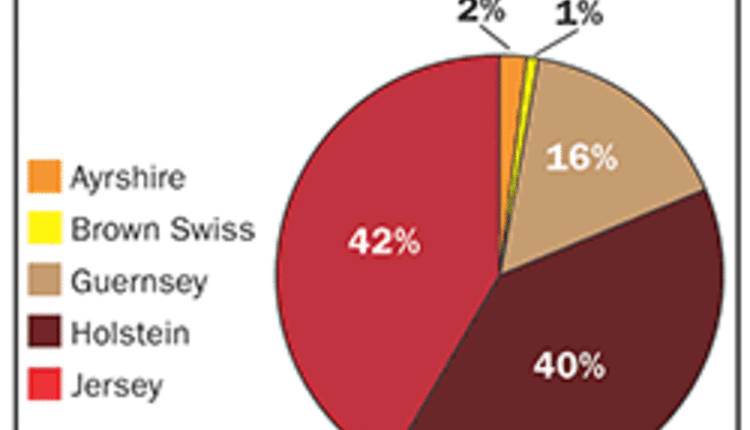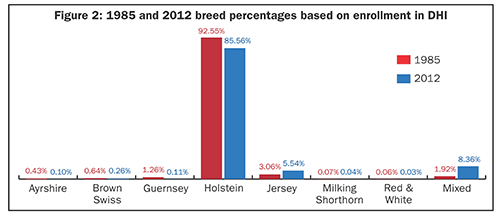The author is a retired breed association executive secretary and dairy cooperative CEO.
 Our industry has changed a great deal during the past century. One of those changes has been the color and attributes of the cows we milk. Specifically, the dairy breed make-up of the national dairy herd, today, compared to the first half of the 20th century is much different. The 1935 U.S. Census of Agriculture estimated there were 23 million dairy cows. Of those 23 million dairy cows, 42 percent were Jersey, followed by Holstein with 40 percent, Guernsey at 16 percent, Ayrshire was 2 percent, and Brown Swiss, 1 percent (see Figure 1).
Our industry has changed a great deal during the past century. One of those changes has been the color and attributes of the cows we milk. Specifically, the dairy breed make-up of the national dairy herd, today, compared to the first half of the 20th century is much different. The 1935 U.S. Census of Agriculture estimated there were 23 million dairy cows. Of those 23 million dairy cows, 42 percent were Jersey, followed by Holstein with 40 percent, Guernsey at 16 percent, Ayrshire was 2 percent, and Brown Swiss, 1 percent (see Figure 1).
Other reliable date exists
Since the 1935 Census of Agriculture survey there is no known record of USDA estimating the breed composition of the nation's dairy herd. Fortunately, there is another reliable source that provides a good estimate - Dairy Herd Improvement (DHI) records. In 1985, National DHI began publishing the number of cows enrolled on DHI test by breed. The data not only includes the five breeds referenced in 1935, but also Milking Shorthorn, Red and White, and Mixed. A herd is designated "Mixed" if the herd does not have 75 percent or more of one single breed. Even though only half of the nation's dairy cows are enrolled in DHI, the DHI data provides us with the best information available to examine trends in which breed of cow dairy farmers are milking.
The 1985 data shows that nearly 93 percent of the cows enrolled in DHI were Holstein. Jersey stood at 3 percent, Guernsey about 1-1/4 percent, Mixed almost 2 percent, and the other four breeds were slightly over 1 percent (see Figure 2).

Read more of this article that appears on page 743 of the November 2013 issue of Hoard's Dairyman.
 Our industry has changed a great deal during the past century. One of those changes has been the color and attributes of the cows we milk. Specifically, the dairy breed make-up of the national dairy herd, today, compared to the first half of the 20th century is much different. The 1935 U.S. Census of Agriculture estimated there were 23 million dairy cows. Of those 23 million dairy cows, 42 percent were Jersey, followed by Holstein with 40 percent, Guernsey at 16 percent, Ayrshire was 2 percent, and Brown Swiss, 1 percent (see Figure 1).
Our industry has changed a great deal during the past century. One of those changes has been the color and attributes of the cows we milk. Specifically, the dairy breed make-up of the national dairy herd, today, compared to the first half of the 20th century is much different. The 1935 U.S. Census of Agriculture estimated there were 23 million dairy cows. Of those 23 million dairy cows, 42 percent were Jersey, followed by Holstein with 40 percent, Guernsey at 16 percent, Ayrshire was 2 percent, and Brown Swiss, 1 percent (see Figure 1). Other reliable date exists
Since the 1935 Census of Agriculture survey there is no known record of USDA estimating the breed composition of the nation's dairy herd. Fortunately, there is another reliable source that provides a good estimate - Dairy Herd Improvement (DHI) records. In 1985, National DHI began publishing the number of cows enrolled on DHI test by breed. The data not only includes the five breeds referenced in 1935, but also Milking Shorthorn, Red and White, and Mixed. A herd is designated "Mixed" if the herd does not have 75 percent or more of one single breed. Even though only half of the nation's dairy cows are enrolled in DHI, the DHI data provides us with the best information available to examine trends in which breed of cow dairy farmers are milking.
The 1985 data shows that nearly 93 percent of the cows enrolled in DHI were Holstein. Jersey stood at 3 percent, Guernsey about 1-1/4 percent, Mixed almost 2 percent, and the other four breeds were slightly over 1 percent (see Figure 2).










